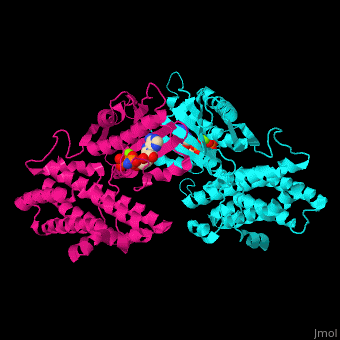Pyruvate dehydrogenase kinase
From Proteopedia
(Difference between revisions)
| (4 intermediate revisions not shown.) | |||
| Line 1: | Line 1: | ||
<StructureSection load='' size='350' side='right' caption='Human pyruvate dehydrogenase kinase isozyme 4 dimer complex with AMPPNP and Mg+2 ion (green) (PDB entry [[2e0a]])' scene='48/485629/Cv/1'> | <StructureSection load='' size='350' side='right' caption='Human pyruvate dehydrogenase kinase isozyme 4 dimer complex with AMPPNP and Mg+2 ion (green) (PDB entry [[2e0a]])' scene='48/485629/Cv/1'> | ||
__TOC__ | __TOC__ | ||
| + | |||
== Function == | == Function == | ||
| - | '''Pyruvate dehydrogenase kinase''' (PDK) is part of the pyruvate dehydrogenase complex. This complex is located in the mitochondria and converts pyruvate to acetyl-CoA as part of the citric acid cycle. PDK phosphphorylates serine residues on pyruvate dehydrogenase using ATP. There are 4 isozymes of PDK. The isozymes differ in length, activity and phosphorylation sites<ref>PMID:11486000</ref>. PDK1 is abundant in heart cells. PDK2 is abundant in mitochondria. PDK3 is abundant in testis. PDK4 is abundant in muscle and heart. | + | '''Pyruvate dehydrogenase kinase''' (PDK) is part of the pyruvate dehydrogenase complex. This complex is located in the mitochondria and converts pyruvate to acetyl-CoA as part of the citric acid cycle. PDK phosphphorylates serine residues on pyruvate dehydrogenase using ATP. There are 4 isozymes of PDK. The isozymes differ in length, activity and phosphorylation sites<ref>PMID:11486000</ref>. |
| + | *'''PDK1''' is abundant in heart cells. PDK1 expression was found to predict future major adverse cardiovascular events<ref>PMID:36866436</ref>. | ||
| + | *'''PDK2''' is abundant in mitochondria. | ||
| + | *'''PDK3''' is abundant in testis. | ||
| + | *'''PDK4''' is abundant in muscle and heart. It is important during starvation for regulation of pyruvate dehydrogenate complex activity and glucose homoeostasis<ref>PMID:16606348</ref>. | ||
== Relevance == | == Relevance == | ||
| Line 23: | Line 28: | ||
*PDK isozyme 2 | *PDK isozyme 2 | ||
| - | **[[1jm6]] – PDK2 + ADP – rat<br /> | ||
**[[2btz]] – hPDK2 <br /> | **[[2btz]] – hPDK2 <br /> | ||
**[[2bu2]] – hPDK2 + benzonitrile derivative + ATP<br /> | **[[2bu2]] – hPDK2 + benzonitrile derivative + ATP<br /> | ||
| Line 30: | Line 34: | ||
**[[2bu7]] - hPDK2 + acetamide derivative<br /> | **[[2bu7]] - hPDK2 + acetamide derivative<br /> | ||
**[[2bu8]] - hPDK2 + dichloro-acetic acid + ADP<BR /> | **[[2bu8]] - hPDK2 + dichloro-acetic acid + ADP<BR /> | ||
| - | **[[4mp2]], [[4mp7]], [[4mpc]], [[4mpe]], [[4mpn]], [[4v25]], [[4v26]], [[5j6a]], [[5j71]], [[5m4k]], [[5m4m]], [[5m4n]], [[5m4p]], [[6lil]], [[6lio]], [[6lin]], [[6tmz]], [[6tmp]], [[6tmq]], [[6tn0]], [[6tn2]] – hPDK2 + inhibitor<br /> | + | **[[4mp2]], [[4mp7]], [[4mpc]], [[4mpe]], [[4mpn]], [[4v25]], [[4v26]], [[5j6a]], [[5j71]], [[5m4k]], [[5m4m]], [[5m4n]], [[5m4p]], [[6lil]], [[6lio]], [[6lin]], [[6tmz]], [[6tmp]], [[6tmq]], [[6tn0]], [[6tn2]], [[7ebh]], [[7eas]], [[7vbu]], [[7vbv]], [[7vbx]] – hPDK2 + inhibitor<br /> |
| - | **[[3crk]], [[3crl]] – hPDK2 + pyruvate dehydrogenase E2 | + | **[[3crk]], [[3crl]] – hPDK2 + pyruvate dehydrogenase E2<br /> |
| + | **[[1jm6]] – PDK2 + ADP – rat<br /> | ||
*PDK isozyme 3 | *PDK isozyme 3 | ||
| Line 42: | Line 47: | ||
**[[2e0a]] – hPDK4 + AMPPNP<br /> | **[[2e0a]] – hPDK4 + AMPPNP<br /> | ||
**[[2zkj]], [[3d2r]] – hPDK4 + ADP<BR /> | **[[2zkj]], [[3d2r]] – hPDK4 + ADP<BR /> | ||
| + | **[[7ea0]], [[7eat]], [[7ebb]], [[7ebg]] – hPDK4 + inhibitor<br /> | ||
**[[2zdx]], [[2zdy]] – hPDK4 (mutant) + inhibitor | **[[2zdx]], [[2zdy]] – hPDK4 (mutant) + inhibitor | ||
}} | }} | ||
Current revision
| |||||||||||
3D structures of pyruvate dehydrogenase kinase
Updated on 04-August-2024
References
- ↑ Korotchkina LG, Patel MS. Site specificity of four pyruvate dehydrogenase kinase isoenzymes toward the three phosphorylation sites of human pyruvate dehydrogenase. J Biol Chem. 2001 Oct 5;276(40):37223-9. Epub 2001 Aug 2. PMID:11486000 doi:10.1074/jbc.M103069200
- ↑ Forteza MJ, Berg M, Edsfeldt A, Sun J, Baumgartner R, Kareinen I, Casagrande FB, Hedin U, Zhang S, Vuckovic I, Dzeja PP, Polyzos KA, Gisterå A, Trauelsen M, Schwartz TW, Dib L, Herrmann J, Monaco C, Matic L, Gonçalves I, Ketelhuth DFJ. Pyruvate dehydrogenase kinase regulates vascular inflammation in atherosclerosis and increases cardiovascular risk. Cardiovasc Res. 2023 Jul 4;119(7):1524-1536. PMID:36866436 doi:10.1093/cvr/cvad038
- ↑ Jeoung NH, Wu P, Joshi MA, Jaskiewicz J, Bock CB, Depaoli-Roach AA, Harris RA. Role of pyruvate dehydrogenase kinase isoenzyme 4 (PDHK4) in glucose homoeostasis during starvation. Biochem J. 2006 Aug 1;397(3):417-25. PMID:16606348 doi:10.1042/BJ20060125
- ↑ Roche TE, Hiromasa Y. Pyruvate dehydrogenase kinase regulatory mechanisms and inhibition in treating diabetes, heart ischemia, and cancer. Cell Mol Life Sci. 2007 Apr;64(7-8):830-49. PMID:17310282 doi:10.1007/s00018-007-6380-z
- ↑ Sutendra G, Michelakis ED. Pyruvate dehydrogenase kinase as a novel therapeutic target in oncology. Front Oncol. 2013 Mar 7;3:38. doi: 10.3389/fonc.2013.00038. eCollection 2013. PMID:23471124 doi:http://dx.doi.org/10.3389/fonc.2013.00038
- ↑ Kukimoto-Niino M, Tokmakov A, Terada T, Ohbayashi N, Fujimoto T, Gomi S, Shiromizu I, Kawamoto M, Matsusue T, Shirouzu M, Yokoyama S. Inhibitor-bound structures of human pyruvate dehydrogenase kinase 4. Acta Crystallogr D Biol Crystallogr. 2011 Sep;67(Pt 9):763-73. doi:, 10.1107/S090744491102405X. Epub 2011 Aug 9. PMID:21904029 doi:10.1107/S090744491102405X

